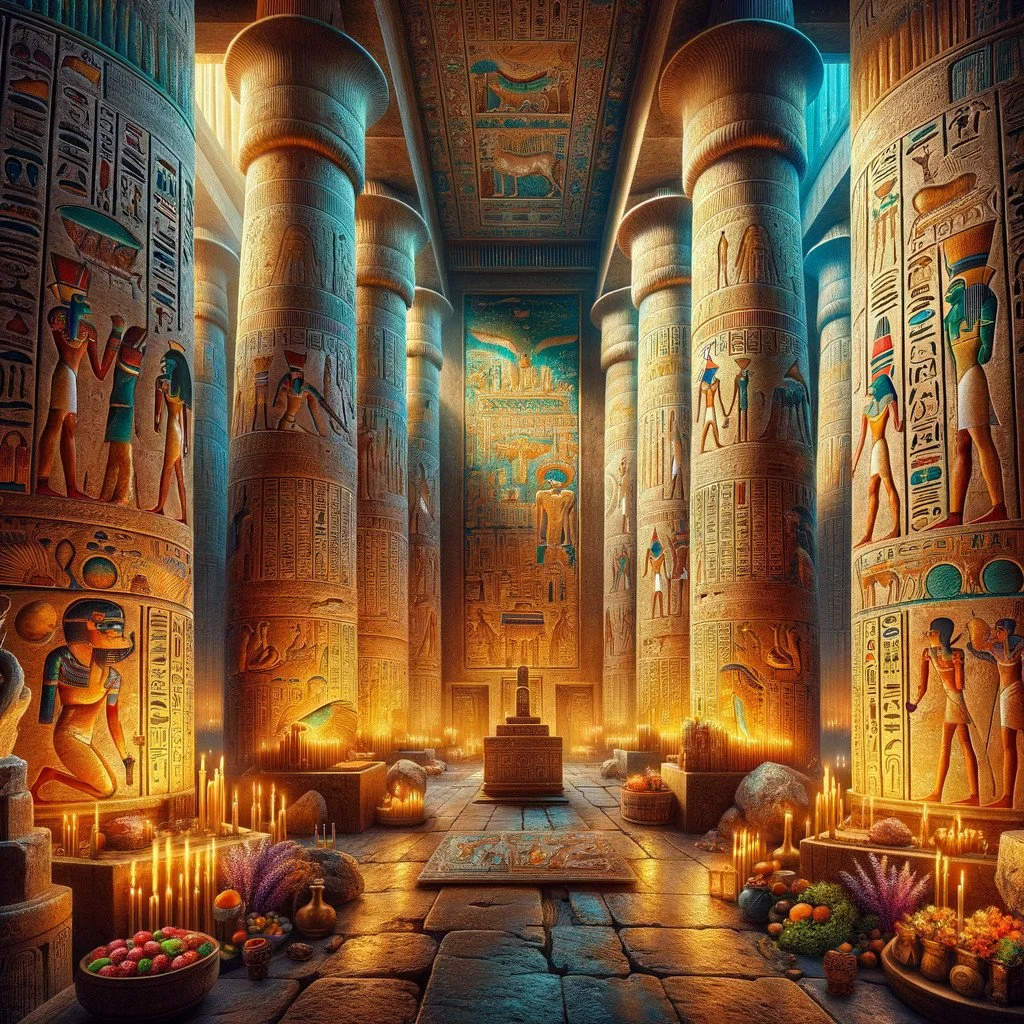Ancient Egypt’s Dream Temples: The World’s First Sleep Clinics ✨😴
An intricately decorated ancient Egyptian temple interior.
Picture this: you’re walking barefoot across cool stone at dusk, the desert heat finally melting into a soft, breathy breeze. Oil lamps flicker like patient stars, washing the temple walls in gold. Somewhere deeper inside, a priest is blending kyphi incense—a heady, sweet mix of honey, wine, cinnamon, and myrrh. The smoke curls upward, lazy and slow, the kind that makes your body exhale before your mind does.
Welcome to Ancient Egypt’s dream temples—3,000 years before sleep trackers, melatonin gummies, or white noise apps, these were the original sleep clinics.
But these weren’t just places to crash. They were spaces built for something far more powerful: dream incubation—a structured, ritualized journey where sleep was a tool, not an afterthought.
The Ritual Begins 🌙
You’d arrive not to be “treated” but to participate. Temple sleep was immersive. The lights dimmed. Chants began—a low, steady rhythm that wrapped around the courtyard like water against stone. Attendants guided you toward a quiet chamber carved into the temple’s inner sanctum.
This wasn’t just any room. It was deliberately cooled, darkened, and hushed—a perfect cocoon for the night’s ceremony. Your senses softened, the noise of the outside world faded, and your mind slipped into that liminal edge where wakefulness blurs into dreaming.
What People Came For 🕯️
Ancient Egyptian wall relief showing incense offerings.
The stakes were real. People traveled to these temples seeking:
Healing from illness
Guidance on life-changing decisions
Messages from the gods
Fertility, forgiveness, or favor
Clarity during times of doubt
Once you lay down, the idea was simple but profound: let the gods speak through your dreams. But really? It was a masterclass in manipulating the sleep environment—long before we had words like “sleep hygiene” or “circadian rhythm.”
The dim lighting, soothing scents, steady sound, and ritualized intention all conspired to make dreams vivid, memorable, and meaningful.
From Temples to Sleep Labs 🛏️
What’s wild is that this wasn’t a fringe practice—it was mainstream medicine.
Later, the Greeks built their own Asclepieia—healing temples where people would sleep, hoping for a vision of Asclepius, god of medicine.
Modern neuroscience calls it targeted dream incubation. Ancient people called it a conversation with the divine.
And if you squint, the parallels with modern sleep rituals are uncanny:
Ritual wind-down → soft light, scent, sound, stillness.
Sacred space → a bedroom cleared of distractions.
Guided intention → going to bed with a purpose, not doomscrolling.
Sound entrainment → chants and drumming echo today’s soundscapes and binaural beats.
We wrap our rooms in pink noise and blackout curtains. They wrapped theirs in chants, firelight, and perfume. Different tools—same instinct.
A Modern Echo 🔮
Close your laptop. Light a candle. Turn on soft ambient sound. Maybe it’s pink noise, maybe it’s rain. Let your room grow dim and warm.
You’ve just recreated a sleep ritual your ancestors practiced 3,000 years ago.
They didn’t stumble into better sleep—they designed it: communally, intentionally, with awe. And even though we’ve swapped temples for bedrooms, the truth lingers like incense smoke: sleep is more than a necessity. It can be a portal.
✨ Your Turn
If you could sleep in a dream temple tonight and get one answer from your dreams—what would you ask?
And what’s your modern temple ritual?
🎧 Sound machine?
🪔 A favorite scent?
📱 Phone on silent and flipped over?
🌿 Rain, pink noise, ocean waves?
#SleepHistory #DreamIncubation #AncientEgypt #SleepScience #SleepRituals #SleepHealth #PinkNoise #SoundSleep #SleepBetter #Wellbeing #SleepHygiene #CBTI #Dreams #NightMagic #BedtimeRituals

